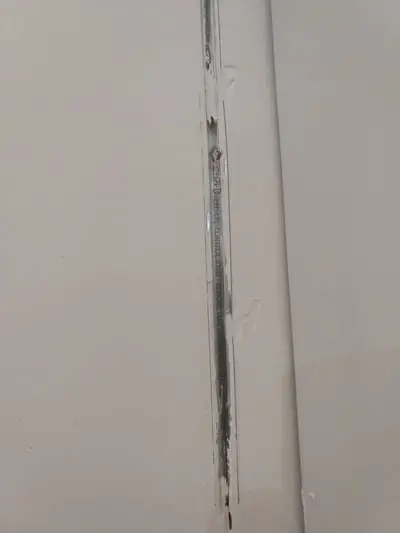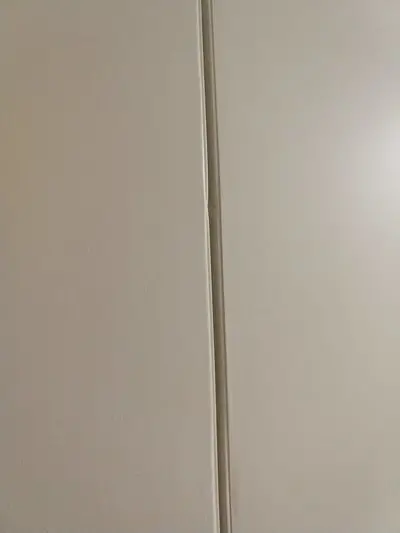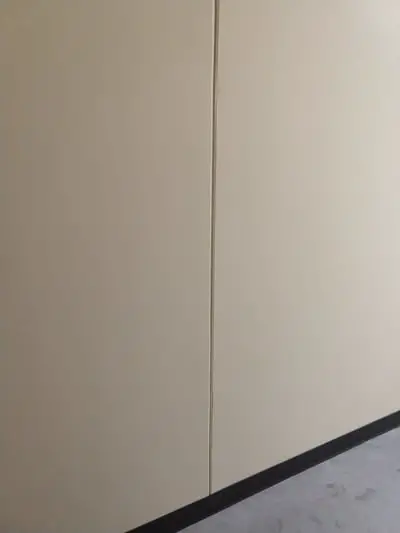
Determine and remove the cause of the crack
If you want to fix drywall cracks, determining and eliminating the cause of cracking is vital. If you don't remove the cause of the crack, taping and finishing it will be pointless. The repair may look good for a few weeks or months at most, but the crack will most likely return.
Drywall is essentially a gypsum-based material formed into a sheet of varying lengths. The gypsum material is covered by a layer of paper that adds strength and makes for a smooth finish. Drywall cracks never occur (well, almost never) in the paper covering gypsum panels. If drywall cracks appear, they do so where two sheets of drywall meet. Drywall seams crack when the two adjacent sheets of drywall move in opposite directions. Knowing this fact helps you determine the cause of the drywall crack you are attempting to repair.
Why do drywall sheets move?
Drywall sheets move because:
- The drywall fasteners failed
- There is insufficient backing to secure the drywall
- Movement of the underlying structure was not accounted for
Poorly placed or insufficient drywall screws
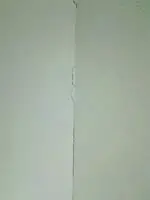 Drywall can be secured using nails, drywall screws, or adhesive. Any of these options can be effective at securing drywall and preventing cracking. When using drywall screws or nails, it is important not to allow the head of the screw to penetrate the paper. Doing so negates the holding power of the fastener and allows the sheet to float freely. Corners of drywall need more screws or nails than the field. If using nails alone, you should generally use twice as many nails as screws. When any of these factors are ignored, it can influence how well a sheet of drywall is secured to the underlying structure. If a sheet is not properly secured, when a building settles it will move away from the sheet next to it and a crack will form.
Drywall can be secured using nails, drywall screws, or adhesive. Any of these options can be effective at securing drywall and preventing cracking. When using drywall screws or nails, it is important not to allow the head of the screw to penetrate the paper. Doing so negates the holding power of the fastener and allows the sheet to float freely. Corners of drywall need more screws or nails than the field. If using nails alone, you should generally use twice as many nails as screws. When any of these factors are ignored, it can influence how well a sheet of drywall is secured to the underlying structure. If a sheet is not properly secured, when a building settles it will move away from the sheet next to it and a crack will form.
You can find out if the crack was caused by insufficient or improperly placed drywall screws by simply pushing on the drywall on either side of the crack. If you notice even a small amount of movement, it likely indicates that the sheet needs to be secured before repairing the crack. Drywall screw pops are another indication that the fasteners failed. To fix this problem, simply add screws to the area around the crack until you eliminate all movement.
Not enough drywall backing
Drywall must be secured every 12 inches in the open part of the sheet and even more at corners and edges. Before hanging drywall, it is important to first check that there is enough backing and that the backing is properly located. The corners of a room are often overlooked. If drywall is hung without enough backing, the sheets will move and, cracks can form.
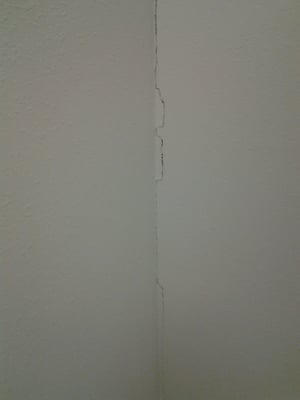 By pushing on the sheet of drywall around where the crack is located, you can learn a lot about the cause of the crack. If it rests securely against a stud, you know that the backing is present but just the fasteners failed. However, if you do not sense a drywall stud behind where the sheet is moving, it is possible that when framing and before hanging drywall, there was not enough drywall backing installed.
By pushing on the sheet of drywall around where the crack is located, you can learn a lot about the cause of the crack. If it rests securely against a stud, you know that the backing is present but just the fasteners failed. However, if you do not sense a drywall stud behind where the sheet is moving, it is possible that when framing and before hanging drywall, there was not enough drywall backing installed.
Eliminating the cause of insufficient drywall backing is not an easy task. You need to gain access behind the sheet of drywall and attach wooden or metal backing to the existing structure. Then, you can secure the drywall to the newly installed backing and repair the crack. In rare cases, you can access the back of the drywall by entering a crawl space in the attic or wall cavity. However, most often this is not possible.
 If you are unable to access the back of the drywall you will need to cut a hole in the drywall and install backing where it is missing. This may seem drastic, but if you are not able to secure the drywall before taping and finishing, it will crack again in the future.
If you are unable to access the back of the drywall you will need to cut a hole in the drywall and install backing where it is missing. This may seem drastic, but if you are not able to secure the drywall before taping and finishing, it will crack again in the future.
You can sometimes get away with cutting a small square hole where the crack is located and repairing it using a strapped backing patch. This method involves attaching small wooden blocking to the existing drywall and then attaching the patch to the new backing. If using this method, make sure to secure the new backing to the sheet next to the sheet you are trying to secure. Remember, your goal is to prevent the two sheets of drywall from moving in opposite directions. If you secure them to one another using a strapped backing patch, it will work similarly to securing both sheets to the underlying structure separately.
However, in most cases a strapped backing patch will not be practical. Instead, you will need to cut a larger hole in the drywall to allow you to attach the backing to the existing structure. Once the backing is in place, you can secure both your patch and existing drywall to the new backing. In all cases, your goal is to secure the drywall and eliminate all movement.
Movement of the underlying structure not accounted for
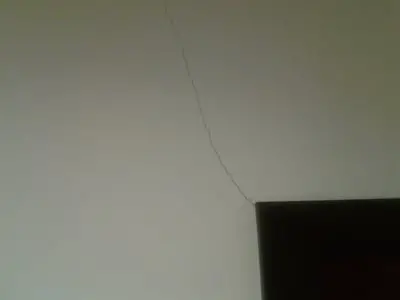 All buildings settle over time. Some movement is cyclical due to the freeze and thaw cycle of the seasons. When constructing a home or larger structure, the potential for slight movements should be considered. There are certain areas of a building that are more prone to movement. Drywall hangers need to be aware of these factors so that they don't inadvertently hang drywall in a way that leads to cracking.
All buildings settle over time. Some movement is cyclical due to the freeze and thaw cycle of the seasons. When constructing a home or larger structure, the potential for slight movements should be considered. There are certain areas of a building that are more prone to movement. Drywall hangers need to be aware of these factors so that they don't inadvertently hang drywall in a way that leads to cracking.
Areas above door and window openings are potential spots for drywall cracks. The weight of the building above a window or door is distributed by the header and down the jack studs on either side of the opening to the floor. Therefore, jack studs carry a lot of the load of the building and therefore are more prone to potential movement. Because of this, you should avoid placing drywall seams on or near jack studs. In other words, a drywall seam should not be located within 12 inches of the edge of a window or door. If you need to locate a drywall seam above or below a window, it is best to do so near the middle of the window.
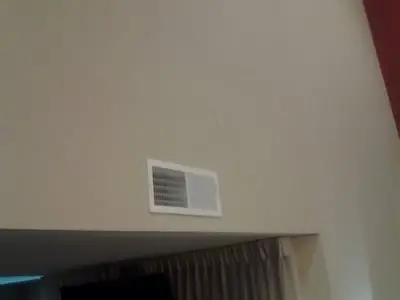 This same principle should be followed when hanging drywall above any load bearing area. If you notice drywall cracks above large openings in open-concept room designs, the drywall seam was likely placed in a poor location. In these cases, you may not notice any unwanted movement when you push on the sheet of drywall. Most likely the sheet of drywall is properly secured but the seam cracked because of a shift in the underlying structure.
This same principle should be followed when hanging drywall above any load bearing area. If you notice drywall cracks above large openings in open-concept room designs, the drywall seam was likely placed in a poor location. In these cases, you may not notice any unwanted movement when you push on the sheet of drywall. Most likely the sheet of drywall is properly secured but the seam cracked because of a shift in the underlying structure.
Drywall cracks caused by this type of problem are the most difficult to remediate. No amount of extra backing can fully eliminate the underlying movement. You can add drywall screws to help strengthen the drywall joint in this area but if the movement is significant, no amount of fasteners can prevent the drywall from cracking.
In cases where significant movement is expected, 1⁄16 inch or more, expansion joints are installed. Properly engineered expansion joints are beyond the scope of this article. They are common in commercial and industrial buildings but less common in residential construction. Expansion joints need to be engineered into the entire structure, not just the drywall. When done properly, they can eliminate the potential for drywall cracks.
Conclusion
Finding and eliminating the cause of movement is essential when attempting to permanently repair drywall cracks. Trying to repair drywall cracks without first eliminating the cause is like putting a Band-Aid on a broken bone. Once you have prevented the drywall from moving, it is time to tape and finish the crack. Please read on to find out how to tape drywall cracks.

